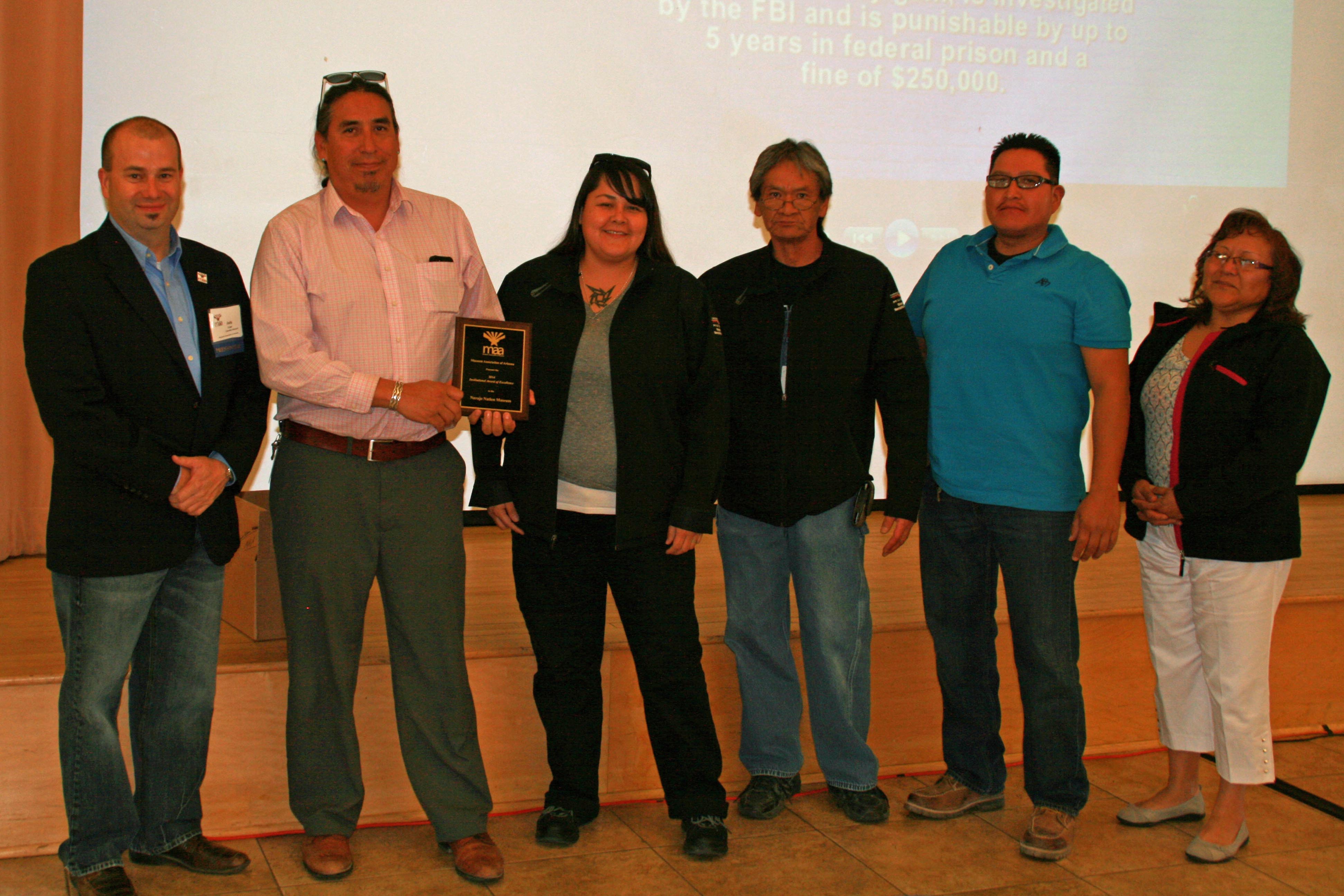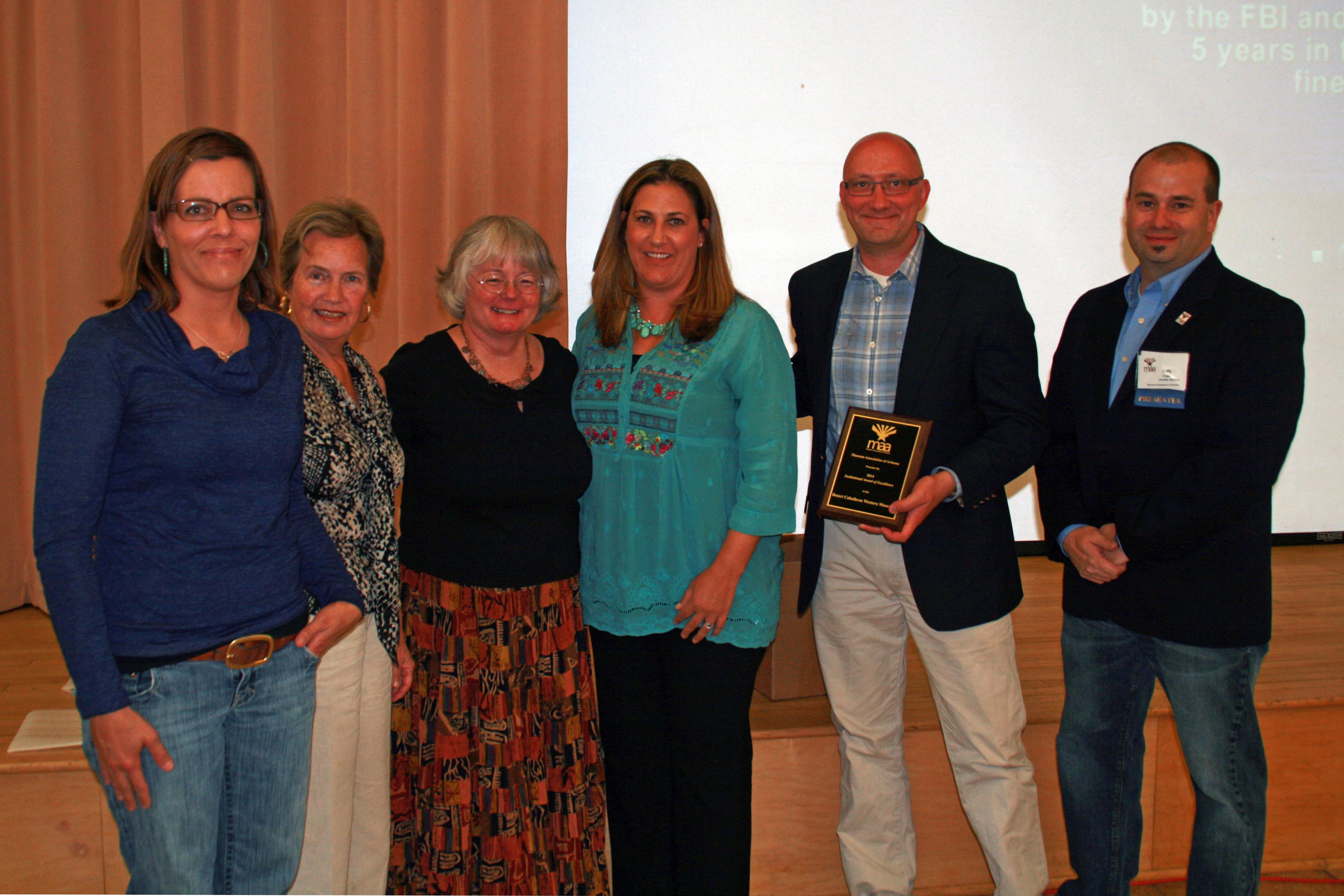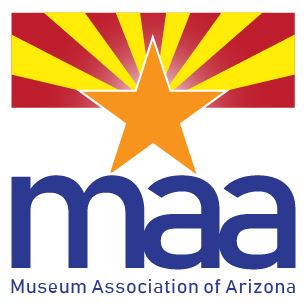Museum Association |
2014 Professional Recognition Awards
Institutional Award of Excellence
Navajo Nation Museum
The Navajo Nation Museum’s work on the Navajo language Star Wars film symbolizes their mutual engagement with their community. The film initially began as a language preservation project, but grew into one that involved the larger community at many different levels. The participants included language instructors from the local colleges, tribal politicians, local actors, traditional elders, recording studios and a major film producer. The resulting film was not only well received by members of the Navajo Nation, but has been shown at venues from San Francisco to New York and featured on the BBC, not to mention a great review on RogerEbert.com.
The benefits of this project to the museum and the community, however, went far beyond bringing an additional language to George Lucas’ multi-lingual universe. Maintaining a connection with traditional language is important for a community’s identity, allowing for the preservation of stories and customs, and promoting intergenerational cohesiveness. The size of the project required making innovative connections both within the community, including many non-museum goers, and with outside groups. Navajo Star Wars may have begun as a community project but it now has international recognition, and has instilled pride in the people who produced it and shown the result of us how a small museum can be successful on a huge scale

Desert Caballeros Western Museum
The Desert Cabelleros Western Museum is given this award for its overall transformation following the implementation of a new strategic agenda in 2011.
Beginning with the adoption of new mission and vision statements, the Museum worked to regain the confidence of its donor community, using a single unsolicited major donation as a leadership gift to kick off its first capital campaign in more than 25 years. The campaign more than met its goal, allowing for the renovation of several galleries for the permanent Western art collection and a new exhibit on the town’s 150 year history.
The Museum’s signature program, the annual Cowgirl Up! Exhibit, has become the most important show in the nation for women Western artists. Other innovations include the Hassayampa Lecture series focusing on the history of the American West, Desert Adventure tours, and a culture walk at the Museum’s D.C. Boyd Ranch, developed in conjunction with area teachers, meeting the 4th grade Arizona State Standards for Social Studies, among many others.
In the words of Trustee Sandy Chamberlain, with “the success of the Museum’s capital campaign, the vision of its Trustees and Executive Director, and the hard work of staff and volunteers…the Desert Caballeros Western Museum now meets the needs of 21st century audiences and is poised to realize its vision of taking its place as a nationally recognized center for Western art, history and culture.”

Individual Award of Excellence
Kathleen Kearney, University of Arizona Museum of Art
Kathleen Keaney’s was unanimously nominated by her co-workers although she is not “technically” a museum professional. Her official job description is Business Manager for the University of Arizona Museum of Art. In practice she is more than that: she is the museum’s institutional knowledge and go-to person for every problem that arises. She is involved in every aspect of the museum, including education, admissions, events, curatorial, collection and administration. During the recent economic downtown she masterfully navigated the museum’s significant budget cuts and fought to keep all staff positions and even bring part-time position to full-time status. She gave generously of her time to assist the museum’s staff in participating in their 2013 Museum Assessment Program survey.
Katy’s colleagues describe her as “the advocate that every museum wants and needs” and their “champion”, or more simply: “Katy is the Museum”.
Alice Jung, Arizona Museum of Natural History and Mesa Historical Museum
It is with some sadness that this award is given to Alice Jung, late Educator at the Arizona Museum of Natural History and Collections Manager at the Mesa Historical Museum.
While Alice’s “day” job was as Educational Service Coordinator at the Arizona Museum of Natural History, during the last eight years of her life Alice devoted herself to the Mesa Historical Museum. Although her position, first as head of educational programming and then as collections manager, was “ part time”, Alice contributed even more time as a volunteer. As chair of the fund-raising Home Tour Committee, and then the Ghost Tour, and then the Mesa Cemetery Tour, Alice not only organized the volunteer labor, but wrote the scripts, and ran dress rehearsals to make sure everyone was well-prepared. She was always the first one to pitch in whenever there was a need for help with programming or exhibits. Alice also oversaw the Mesa Historical Museum’s volunteer program and went the extra mile to work with teen volunteers. She mentored them and made sure that they learned valuable skills that they could take into their lives as adults. And through it all, she did everything with a smile and a great attitude.
Community Support Award
Richard A. Collins, Tucson Presidio Trust for Historic Preservation
For the last five years Richard A. Collins has been the President of the Tucson Presidio Trust for Historic Preservation, the volunteer organization that creates the museum exhibits and demonstrates living history days at Presidio San Agustin del Tucson, in downtown Tucson AZ.
During that time Rick has enlivened this small group of volunteers to bring the Presidio to life, expanding their activities and increasing their ranks to include over a dozen soldiers in the garrison ranks and about 20 civilian interpreters that share in the fun of living history the second Saturday of each month.
Rick oversees the children’s program, a school field trip called “Friday at the Fort”. This year more than 1000 students have taken advantage of this program, designed by Jean Baxter, Vice President for Education. It aligns with the state standards in the fourth grade curriculum and is continually touted by teachers, parent chaperones and students, as the “best field trip ever”. Rick has encouraged volunteers to continue to participate in this program, leading by example by participating in all of them as the Fort Commander or one of the “Soldados de Cuera” for the day.
Rick has single-handedly built exhibits in the small museum room. Exhibits such as “Symbols of our Mexican Past” and “A Bite to Eat – foods of the Spanish Colonial Southwest” have been designed, built and coordinated by Rick. With the help of generous donations, Rick has been able to showcase artifacts relevant to the Spanish Colonial time period for which the Presidio emphasizes.
As a volunteer for the organization itself, Rick has put in countless hours of organizing, negotiating with, overseeing, coordinating, managing, fixing and building the Presidio, its volunteers and the city employees with whom the Trust works in partnership. He finds time to docent at the Presidio once a week and participates in the living history demonstration days as well as leading numerous tours on a monthly basis.
Rick’s enthusiasm and passion for history, especially Tucson’s beginnings, is contagious. He brings life to the subject in the lectures he gives, the docent tours he leads and during living history demonstrations. When his eyes light up at a question asked by the public, you can be guaranteed an insightful explanation with fascinating tidbits of information will follow.
Barbara Eschbach, Arizona State University and Chandler Unified School District
In 1990 Barbara Eschbach became the Founding Director of the ASU Computing Commons Gallery, specifically designing the space to support technology-based exhibitions as part of the ASU Computing Commons. Over the next she collaborated with the ASU Institute for Studies in the Arts, founded by Dr. Richard Loveless, and together, they programmed over 50 technology-based exhibitions over 10 years. The work of ASU faculty, researchers and students was featured along with nationally-recognized artists n the US and beyond. Four exhibitions received featured articles/recognition in the academic weekly publication, The Chronicle of Higher Education. During her tenure Barbara was contacted by other institutions for assistance in the design of their technology-based spaces including the Scottsdale Museum of Contemporary Art; the Tempe Center for the Arts; and, most notably, the Whitney Museum in NYC.
Barbara was the founding Co-chair of the ASU Museums, Collections and Galleries Committee and the popular, annual event, “We love Our ASU Museums, Collections and Galleries Day,” which opens all such venues for exploration by the ASU students, faculty and staff as well as off-campus visitors.
She was also the curator of an extensive public art collection within the ASU Computing Commons Building (all four floors). Many of the pieces in this collection came from the exhibitions in the ASU Computing Commons Gallery, together with contributions from technology vendors (e.g., Silicon Graphics, Bell Laboratories). In 2010 Barbara was instrumental in transferring this collection to the Phoenix Sky Harbor Art Collection, under the direction of Lennee Eller, making it more widely accessible.
Since retiring from ASU in July 2008, Barbara has continued to support the community with her interests and extensive knowledge of visual arts of all types. Notably, she is a volunteer for the Art Masterpiece Program of the Chandler Unified School District. Not only does she present classes on specific artists to her grandson’s first grade class at SanTan Elementary School, she suggested and now publishes a monthly, electronic newsletter, “What’s Happening in the Arts?,” which is distributed to all CUSD elementary schools.
Distinguished Service Award
Pamela Levin
Pamela Levin has enjoyed a lengthy career with Arizona museums and the Museum Association of Arizona. She began as a volunteer working at Sylvia Plotkin Judaica Museum on the campus of Congregation Beth Israel, where she later became Director. In 2002 she won an MAA award for her work at that museum.
Pam earned her Certificate in ASU’s Museum Studies program and soon became involved not only with MAA, but with the Museum Educators Council of Arizona where she served as secretary in the 1990s.
Pam joined the MAA Annual Conference Planning Committee in 2000, and has served on that Committee for more than 10 years as the Registration Chair, collecting, compiling and coordinating the registrations of attendees, creating an attendees list for each conference, and manning the Registration and Information desk at all those conferences. As a member of the MAA Board she was Co-Chair of the 2013 conference in Tucson, as well as this year’s conference.
Pam served on the Community Planning Committee, working on the development of the 2005-2010 MAA Five Year Strategic Plan. In addition to reexamining the MAA mission, this plan created a framework of standing committees with specific responsibilities for Governance, Membership, Professional Development and Public Relations, making it possible for MAA to become more stable and sustainable.
In 2005 Pam worked with then MAA President Patricia Smith to create the current MAA Operations Manual that provides guidelines for each of the officers of the organization. She was also involved in creating the MAA Conference Planning Manual.
As MAA from Coordinator from 2004 to 2010, Pam regularly went “above and beyond” her part-time staff position responsible for membership development and assisting the board.
Lisa Anderson
Lisa Anderson made her first appearance on the MAA Board in 2002 as the CAMA Representative, moving up the ranks to become President Elect and then President from 2008 to 2010. While a term as Immediate Past President is usually next, with a quiet retirement after that, Lisa graciously agreed to stay on the MAA Board as our leadership changed, ultimately serving for four years, during which time she oversaw the Nominations and Awards Committees, two of the Associations most challenging jobs.
Lisa was an integral part of the 2003 Community Planning Committee whose work resulted in the 2005-2010 Strategic Plan and in 2010 she led the Association in developing its second five year plan, again reviewing and revising the organizational mission and strategic goals.
Beyond her work for MAA Lisa has been a strong advocate for Arizona museums as a member of the Western Museum Association and in her current position on the American Association for State and Local History Leadership Awards Committee.
Last, but not least, Lisa is a fearless innovator in the wider museum community. As one of the primary conveners of the East Valley Museum Coalition and the informal “Rebel Call” (some of whose non-Arizona members joined us here), she inspires her colleagues to think – and act – in new paradigms and models.
